Intel Atom D510: Pine Trail Boosts Performance, Cuts Power
by Anand Lal Shimpi on December 21, 2009 12:01 AM EST- Posted in
- CPUs
Meet the Board
We’ve got two Pine Trail articles for you today. I’m looking at the dual-core nettop version while Jarred is looking at the first Pine Trail netbook: ASUS’ EeePC 1005PE.
Intel sent me their first desktop Pine Trail motherboard: the D510MO(B). It’s a rather pedestrian looking mini-ITX design with a single 32-bit PCI slot (no PCIe) and a mini-PCIe socket on board.
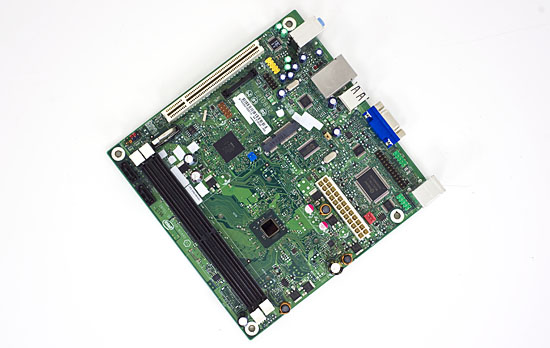
Unlike previous desktop Atom motherboards, the D510MO(B) is entirely passively cooled. Here Intel is benefitting from the lower power characteristics of the Pine Trial platform, showoffs. You get a single large heatsink covering the Pineview Atom CPU, while the tiny NM10 sits naked outside.
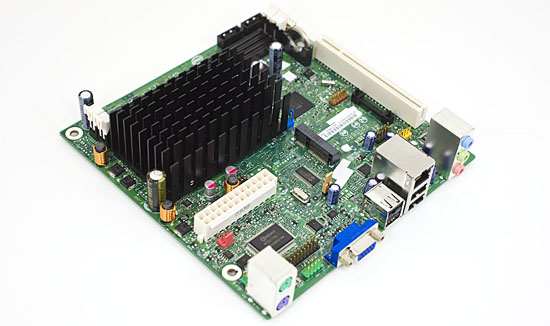
Intel's Pine Trail board with heatsink
Another welcome change is the inclusion of two DIMM slots, despite Pineview only offering a single 64-bit DDR2 memory channel. You get two SATA ports as well.
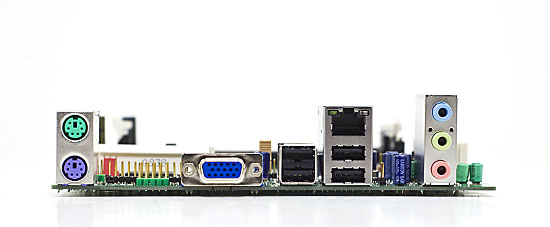
Flip around to the rear of the board and the I/O panel is devoid of any excitement. Four USB ports, Ethernet, PS/2 keyboard/mouse, three 1/8” audio jacks and a VGA output are all you get. Granted the board only costs $75 new, but would it have killed Intel to include DVI or HDMI out? Let’s advance the industry folks, even at the low end.
I suspect that it’s more of a ploy from Intel to characterize Pine Trail as an entry level machine and not something you go around plugging into HDTVs, after all it can’t decode 1080p H.264 video. Leave those sorts of things to Ions.
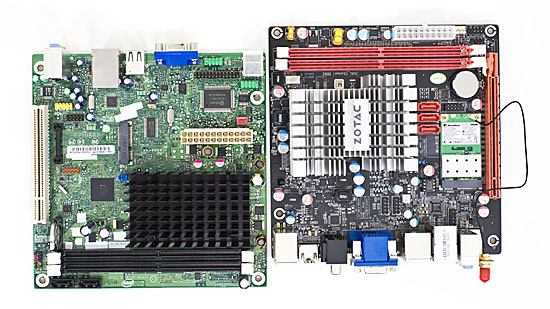
Intel's Pine Trail desktop board (left) vs. Zotac's latest Ion board (right)
Intel stuck the D510MO(B) in a mini-ITX chassis equipped with its own external DC power supply to demonstrate its usefulness as a complete system. While not quite as sexy as the latest Ion platforms, it shows you exactly what you can do with one of these motherboards.
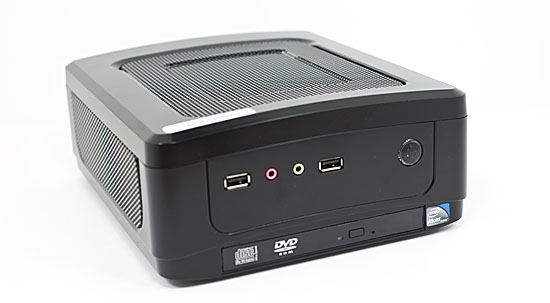
A fully passively cooled Pine Trail mini-ITX system
If you have a truly archaic desktop or want to add a third, fourth, fifth or fileserver PC to your network, grab one of these motherboards and using some relatively old/spare hardware you can build a functional machine. That’s the goal and in that capacity it works quite well. The cheapest Ion motherboards will run you over $110 and even then, in general usage tasks, they are actually slower. It’s only if you’re building a HTPC that Pine Trail disappoints, for a desktop or file server, you’re better off with Intel.











41 Comments
View All Comments
Jeffk464 - Monday, December 21, 2009 - link
This might be a decent solution with the broadcom media chip making it capable of playing HD content and hopefully flash media.dealcorn - Monday, December 21, 2009 - link
If I am reading correctly the Intel platform with Broadcom media accelerator (about $25) is cheaper than the Ion platform and will consume less energy. Some relevant perfortmance testing may help determine whether the Intel platform is positioned to dominate the frugal HTPC market.It is a bummer that you will need to spend chump change for a SATA port card to enable software raid 5 for a frugal media server.
Likely, the incremental performance improvements are adequate for Intel to maintain its cachet in the dissed, real world netbook market with its surprisingly large volumes.
Its kinda a nothing platform, but in context may be a home run.
Jeffk464 - Monday, December 21, 2009 - link
For it to be a solution for me it needs to be on a mobo that has a pcie slot and hdmi through the broadcom chip. I'm not to hopeful though, will probably end up with a i3 solution. Too bad, I like the idea of going super low wattage.psychobriggsy - Monday, December 21, 2009 - link
The platform is standing still apart from getting more integrated. Hopefully that will mean cheaper. Maybe some netbooks will get cheaper, but otherwise the platform is a complete waste of time because of the lack of HD video capability (for Intel to call the graphics "HD Graphics" is verging on consumer misrepresentation, it can't even do 1080p output via HDMI/DVI, what is this, 2005?).Why did the review concentrate on benchmarks of applications nobody would run on such a system?
These chips are a solution for nothing apart from the unwealthy Office user who needs 8 hours of battery instead of 6.
Jeffk464 - Monday, December 21, 2009 - link
It can be used for a low power/cost network storage device.Zool - Monday, December 21, 2009 - link
There could be a test with underclocked and undervolted E5300 against the Atom D510. Maybe Power vs performance would be quite close if not better for the E5300. I think that everyone could take another 10W for a performance thats not crapy (even netbooks).Calin - Monday, December 21, 2009 - link
10 more watts would mean going from 8-9 hours of socket-free operation down to 6 (or maybe less). Not acceptable for the people that want 8 hours of socket-free operation. As for higher performance CPU, you have the low voltage processors (CULV), which will better fit the bill.Zool - Monday, December 21, 2009 - link
Thing is that 10+ more wats in CPU doesnt mean that u use it all the time. For internet browsing and so (not like u can use it efectivly for something more) the cpu isnt working 100% all the time just sporadicly.Majority of the power usage in those scenarios is in the rest of the hardware like display ,gpu, mainboard which runs all the time.
And i dont even say that with faster cpu the task are faster done so u use the cpu on 100% state less time in total.
Atom is the only one of its kind now and without competition it will stay this crapy for long time.
cjs150 - Monday, December 21, 2009 - link
There are 3 markets for this type of product: notebooks, HTPC and cheap file servers:HTPC market: complete failure because the graphics are not up to scratch
Cheap file server: only SATA ports but I could add my raid card to this but the given the cost it would be cheaper to buy a NAS box
Notebooks: barely adequate - word processing and simple internet browsing only.
So for 2 out of 3 markets it is a waste of space and the 3rd market it is merely sub-par what is already out there
Jeffk464 - Monday, December 21, 2009 - link
Don't give up yet, mobo manufacturers have the option to put a broadcom media chip on their boards. I don't know if this will come with HDMI though. Have to wait and see.